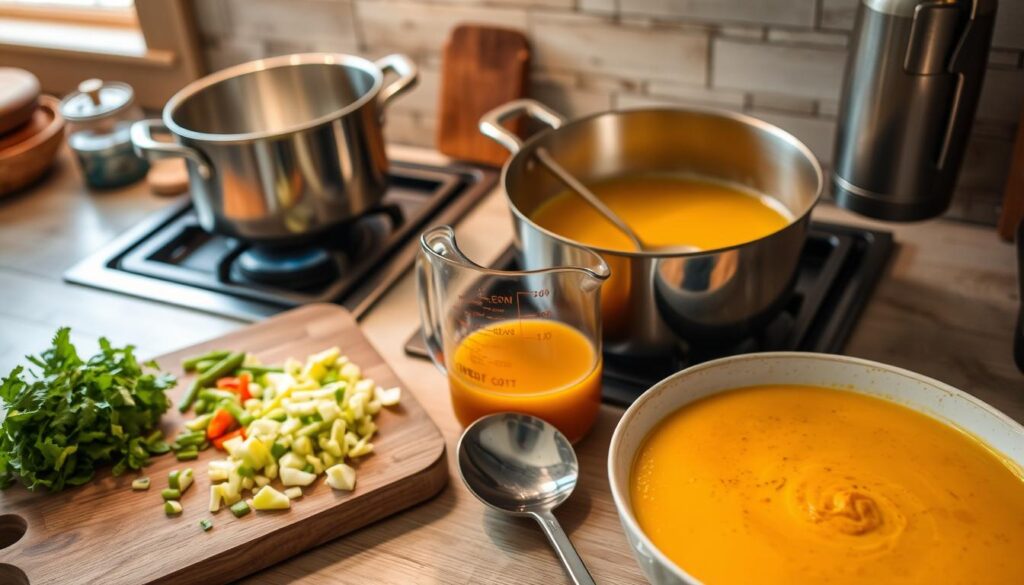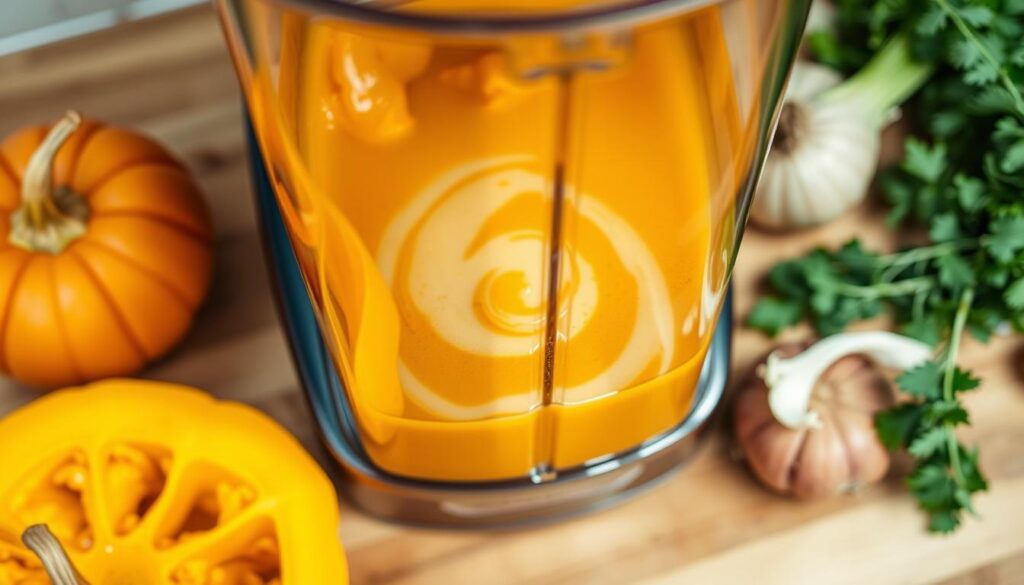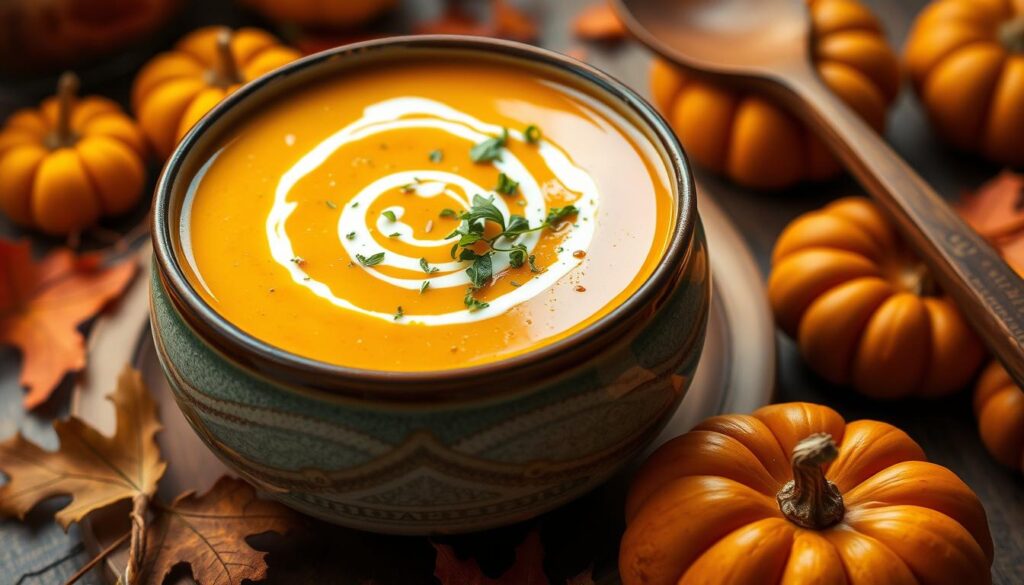As autumn arrives, the air grows crisp and leaves change colors. A warm bowl of homemade pumpkin soup is perfect for soothing your soul. This recipe is easy to make and combines a smooth texture with rich flavors. It’s great as a starter or a main dish for fall and winter gatherings.
Key Takeaways
- Homemade pumpkin soup is a comforting and versatile fall and winter dish
- The recipe is easy to prepare, making it an ideal choice for busy weeknights
- The soup features a rich, velvety texture and aromatic flavors
- Pumpkin is a nutritious ingredient, providing a range of vitamins and minerals
- The soup can be served as a starter or a main course, making it a great option for a variety of occasions
Why Homemade Pumpkin Soup Belongs in Your Recipe Collection
Making a nutritious pumpkin dish at home is a special treat. It’s more than just a meal; it’s an experience. Homemade pumpkin soup offers many benefits that make it a great choice for your seasonal cooking.
One big plus is being able to change the flavors to your liking. You can make it smooth or chunky, depending on what you prefer. This lets you create a dish that’s just right for you.
Also, making your own soup can save money. You can buy fresh ingredients and make a delicious, nutritious pumpkin dish for less than store-bought options.
But the best part is the joy of making it yourself. It’s a way to connect with your food and feel proud of what you’ve made. It turns eating into a fun journey.
“Homemade pumpkin soup is the ultimate comfort food – it warms the soul, nourishes the body, and brings people together around the table.”
As the weather cools, homemade pumpkin soup is a cozy reminder of the harvest season. It invites us to enjoy the moment and cherish the traditions of the time.
Essential Ingredients for the Perfect Creamy Pumpkin Soup
Making a delicious pumpkin soup needs the right ingredients. You must pick the best pumpkin varieties for soup. Also, finding the right mix of herbs and spices is key. Each part is crucial for a soup that’s rich, creamy, and full of flavor.
Choosing the Right Pumpkin Variety
The base of a great pumpkin soup is the pumpkin you choose. Any pumpkin will do, but some are better for soups. They have more moisture and a smooth texture. Try Sugar Pie, Cinderella, or Kabocha pumpkins for a creamier soup with a deeper flavor.
Fresh vs Canned Pumpkin Puree
Deciding between fresh pumpkin and canned pumpkin puree is up to you. Fresh pumpkin gives a real, earthy taste but takes more time to prepare. Canned pumpkin is quick and easy, with consistent quality. Make sure your pumpkin is fresh, ripe, and without blemishes.
Herbs and Spices That Elevate the Flavor
- Warm soup spices like cinnamon, nutmeg, and ginger add depth and complexity to the pumpkin soup.
- Fresh herbs such as sage, thyme, and rosemary provide a herbaceous note that complements the sweetness of the pumpkin.
- A touch of black pepper and a sprinkle of salt help balance the flavors and enhance the overall taste.
By picking the right pumpkin varieties for soup, choosing between fresh pumpkin or canned pumpkin puree, and adding the perfect herbs and spices, you’re on your way to a fantastic creamy pumpkin soup.
Kitchen Tools and Equipment Needed
Making a tasty pumpkin soup needs more than just a saucepan and spoon. You’ll need some key soup-making tools and kitchen gear. Let’s explore the must-haves for your blender for soup and stockpot cooking.
First, you’ll need a big, heavy-bottomed stockpot or Dutch oven. It’s where you’ll simmer the soup ingredients and mix the flavors. Make sure it’s at least 4 to 6 quarts to hold your pumpkin soup.
An immersion blender or a regular blender is crucial for the creamy pumpkin soup texture. The immersion blender blends the soup right in the pot. A traditional blender needs you to transfer the soup in batches.
- A sharp chef’s knife for cutting the pumpkin and other veggies
- A sturdy cutting board for chopping safely
- Measuring cups and spoons for exact ingredient amounts
- A ladle for serving the soup
- Optional: A food processor for quick pumpkin puree (if using fresh pumpkin)
With these soup-making tools ready, you’re set to make a creamy and comforting pumpkin soup. It will surely warm your soul.

Step-by-Step Pumpkin Soup Recipe
Making a cozy and creamy pumpkin soup at home is simple. Just follow these easy steps to make a tasty homemade pumpkin soup that will please your taste buds.
Preparing the Pumpkin
First, pick a ripe and tasty pumpkin. Cut it in half, remove the seeds, and peel it. Then, cut the flesh into 1-inch cubes for even cooking.
Sautéing the Base Ingredients
In a big pot or Dutch oven, melt butter over medium heat. Cook diced onions, garlic, and other veggies like carrots or celery until they’re soft and smell good. This step is key for the pumpkin soup instructions.
Blending and Finishing Touches
When the pumpkin cubes are tender, add them to the pot with broth, cream, herbs, and spices. Let it simmer until the pumpkin is very soft. Then, blend the soup until it’s smooth. Season with salt and pepper, and add maple syrup or brown sugar for extra flavor.

With these easy pumpkin soup instructions, you’ll make a comforting and tasty homemade pumpkin soup. It’s perfect for warming up on a cold day.
Tips for Achieving the Perfect Creamy Texture
Getting a smooth and creamy texture is key to a great pumpkin soup. Here are some tips to help you achieve this:
- Blend, Blend, Blend: The right blending is essential for a creamy soup texture. Use a strong blender or immersion blender to make the soup silky smooth.
- Adjust Liquid Ratios: The mix of broth, cream, or milk affects the soup consistency. Start with more liquid, then adjust to get the smooth pumpkin soup you want.
- Embrace Dairy: Adding heavy cream, half-and-half, or coconut milk can make your soup creamy. Try different amounts to find what you like best.
With these tips, you’ll make a creamy, velvety pumpkin soup that everyone will love.

“The secret to a truly exceptional pumpkin soup is all in the texture. With a few easy tips, you can transform a good soup into a masterpiece of creaminess.”
Nutritional Benefits of Pumpkin Soup
Enjoying a warm bowl of pumpkin soup is more than just a treat. It’s packed with vitamins, minerals, and antioxidants. This healthy soup recipe is perfect for those looking for a low-calorie meal that’s good for you.
Vitamins and Minerals
Pumpkin is the main ingredient in this soup. It’s full of vitamin A, which is great for your eyes, immune system, and skin. It also has vitamin C, an antioxidant that fights off free radicals.
The soup is rich in potassium and iron too. Potassium helps control blood pressure, and iron is key for healthy red blood cells and oxygen transport.
Dietary Considerations
- High in Fiber: Pumpkin soup is a great source of dietary fiber, which promotes digestive health and can help maintain a healthy weight.
- Suitable for Various Diets: This soup can be easily incorporated into various dietary plans, including vegetarian, vegan, and gluten-free diets.
Caloric Content
A typical serving of homemade pumpkin soup has about 100-150 calories. It’s a low-calorie meal that you can enjoy without feeling guilty.
| Nutrient | Amount per Serving |
|---|---|
| Calories | 120 |
| Total Fat | 4g |
| Carbohydrates | 16g |
| Fiber | 4g |
| Protein | 3g |
| Vitamin A | 200% DV |
| Vitamin C | 15% DV |
| Potassium | 12% DV |
| Iron | 6% DV |
This comforting soup is a great addition to your recipe collection. It offers both delicious taste and health benefits in every spoonful.

Serving Suggestions and Garnishes
Enhancing your homemade pumpkin soup’s presentation can make it truly spectacular. It’s perfect for a cozy dinner or a fall party. There are many ways to make this autumnal dish stand out.
Think about pumpkin soup toppings that boost both taste and texture. Toasted pumpkin seeds add a nice crunch. Sour cream or crème fraîche bring a cool, creamy touch. For a savory kick, try crispy bacon bits or caramelized onions as soup garnishes.
- Toasted pumpkin seeds
- Swirl of sour cream or crème fraîche
- Crispy bacon bits
- Caramelized onions
For a better soup presentation, pair it with sides that complement it. A warm baguette or garlic-rubbed crostini is a great choice. It absorbs all the soup’s goodness. A fresh salad also pairs well, balancing the soup’s richness.
“Pumpkin soup is the ultimate fall comfort food, and with a few simple garnishes, it can truly shine on the table.”
Choose a garnish that suits your taste, whether it’s fancy or rustic. The goal is to highlight the pumpkin soup’s natural flavors. With a bit of creativity, you can turn a simple soup into a feast for the eyes and taste buds.
Storage and Reheating Guidelines
After enjoying your homemade pumpkin soup, you might have leftovers. It’s important to store and reheat them right to keep the soup fresh and tasty. Here are the best ways to store and reheat your pumpkin soup.
Freezing Instructions
Pumpkin soup freezes well, perfect for making in bulk. Cool the soup completely before putting it in an airtight container. Make sure there’s room at the top for it to expand. Your soup will stay tasty and fresh in the freezer for up to 3 months.
Best Containers for Storage
- Glass jars or airtight plastic containers are great for refrigerating your soup. They keep air out and keep the soup fresh for 3-4 days.
- For freezing, use heavy-duty, freezer-safe bags or containers. Remove as much air as you can to prevent freezer burn and keep the soup’s texture.
When reheating your pumpkin soup, do it gently. Heat it on the stovetop over low heat, stirring now and then. Don’t let it boil too fast, as it can curdle. You want to warm it up without losing its creamy texture.
By following these easy storage and reheating tips, you can enjoy your homemade pumpkin soup again and again. Whether it’s fresh or reheated, it’s a delicious taste of autumn all year round.
Common Mistakes to Avoid When Making Pumpkin Soup
Making the perfect pumpkin soup is a fun journey, but watch out for common mistakes. One big error is overcooking the pumpkin, making it mushy. To avoid this, keep an eye on the cooking time and check if the pumpkin is tender.
Another mistake is not seasoning the soup enough. Don’t be shy to try different herbs and spices. This can really boost the flavor, like soup-making errors, pumpkin soup tips, and troubleshooting soup recipes. Finding the right mix of seasonings can make your soup stand out.
Also, using the wrong type of pumpkin can affect the soup’s taste and texture. Choose a sweet, dense pumpkin like Sugar Pie or Kabocha for a creamy, tasty soup. With these tips, you’ll make a delicious pumpkin soup every time.
FAQ
What is the best type of pumpkin to use for this creamy pumpkin soup recipe?
Sugar pumpkins or pie pumpkins are the best for flavor and texture. They have a sweeter, denser flesh that’s perfect for creamy soup.
Can I use canned pumpkin puree instead of fresh pumpkin?
Yes, you can! Canned pumpkin puree is easy and delicious. It ensures consistent quality and simplifies the soup-making process.
What herbs and spices go best with pumpkin soup?
Cinnamon, nutmeg, and ginger are classic spices that go well with pumpkin. Adding fresh herbs like sage, thyme, or rosemary can also enhance the flavor.
Do I need any special equipment to make this pumpkin soup?
You’ll need a large stockpot, an immersion blender or regular blender, and a sharp knife. These basics will help you make a smooth, creamy pumpkin soup.
How can I achieve the perfect creamy texture for my pumpkin soup?
Blend the soup well with an immersion blender or regular blender. Adding a bit of heavy cream or coconut milk can also make it creamier.
What are the nutritional benefits of pumpkin soup?
Pumpkin soup is full of vitamins, minerals, and antioxidants. It’s rich in vitamin A, fiber, and other nutrients. Plus, it’s low in calories, making it a healthy meal choice.
What are some tasty garnishes or toppings for pumpkin soup?
Try adding toasted pumpkin seeds, a drizzle of cream or yogurt, crispy bacon bits, or fresh herbs like sage or thyme. These toppings add texture, flavor, and a nice presentation.
How long can I store leftover pumpkin soup?
Leftover soup can be stored in the fridge for 3-4 days. You can also freeze it for up to 3 months. Just use airtight containers and reheat gently when you’re ready to eat it.
Share this post: on Twitter on Facebook





